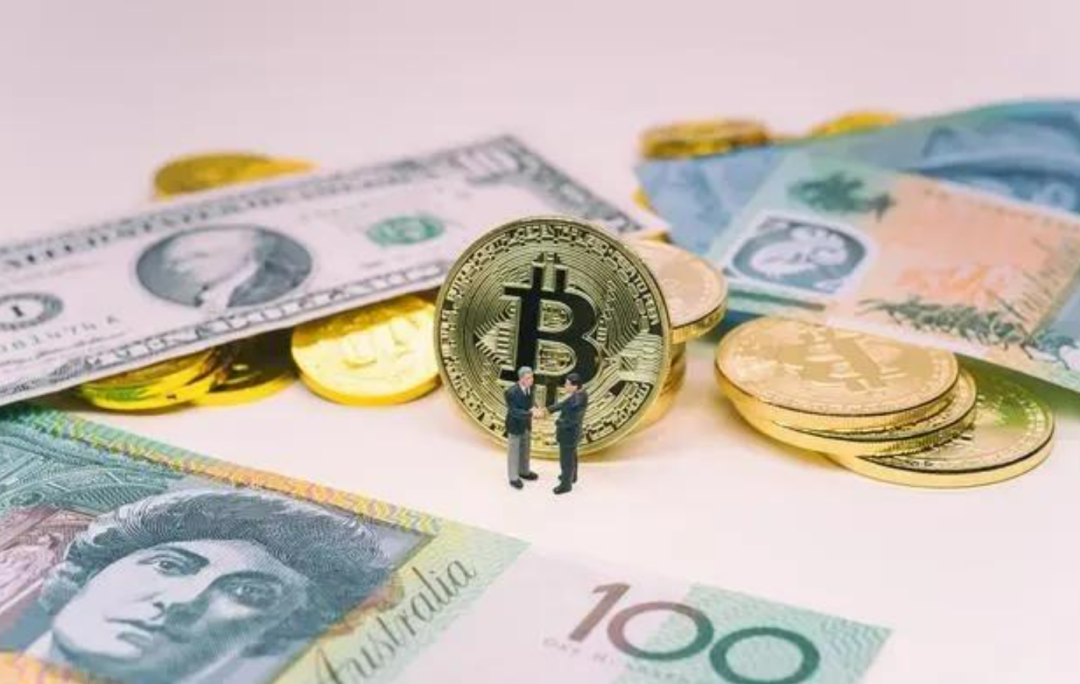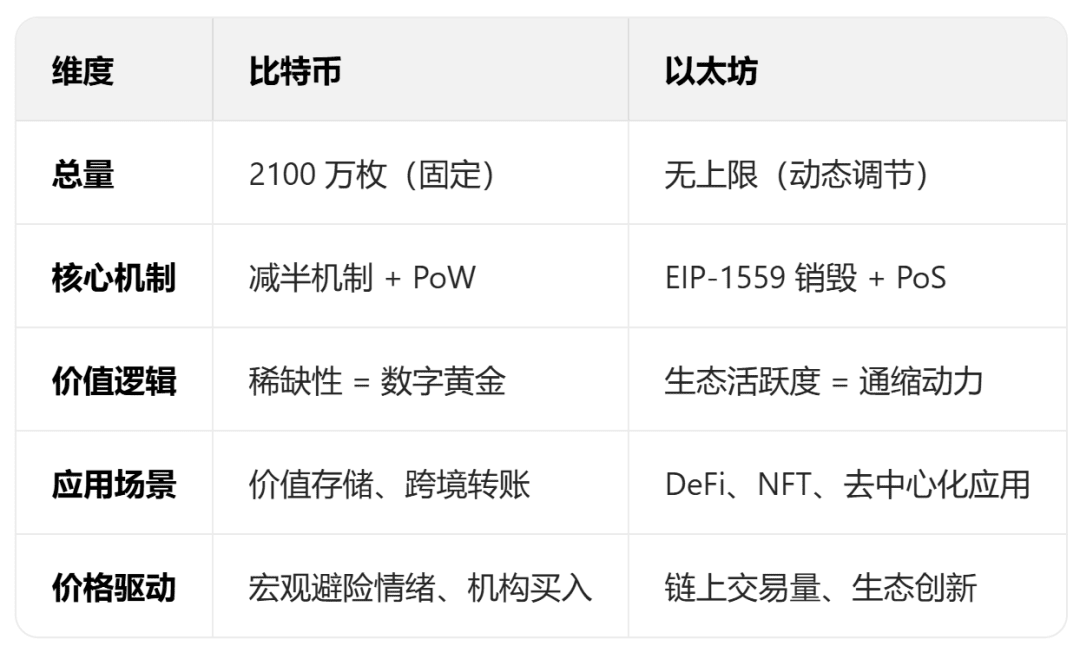In the world of cryptocurrency, Bitcoin and Ethereum are like two mountains — one is synonymous with 'digital gold,' while the other is the 'super operating system' for decentralized applications. Together, their market capitalization accounts for half of the entire crypto market, but the economic logic behind them is completely different: Bitcoin protects its scarcity with a strict deflationary model, while Ethereum transitions from inflation to deflation, playing a game of 'dynamic balance.'
What are the mysteries behind these two models? How do they shape their respective values, and what future do they face?
Bitcoin: 'Digital gold' anchored by mathematics

When Satoshi Nakamoto designed Bitcoin, he embedded a world-changing setting: the total supply will always be 21 million coins. This number acts like a strict law, giving Bitcoin an inherent 'anti-inflation' gene since its inception.
Even better is the 'halving mechanism' — every 210,000 blocks mined (about 4 years), the reward for miners is halved. When it launched in 2009, mining one block could earn 50 bitcoins; after the first halving in 2012, it became 25; after the third halving in 2020, it dropped to 6.25; and by the fourth halving in 2024, the reward will be 3.125. At this rate, it won't be until 2140 that all bitcoins are mined.
This design makes Bitcoin's new issuance increasingly scarce, akin to gold mining — the harder it is to mine over time, the stronger the scarcity becomes.
The trump card of the deflationary model: Anti-inflation + Hedging
In an era where fiat currency can be printed infinitely by central banks, Bitcoin's 'fixed supply' has become a fatal attraction.
A tool to hedge against inflation: In countries like Argentina and Turkey, which suffer from currency devaluation, the public has long regarded Bitcoin as a 'lifesaver.' In 2023, the Argentine peso depreciated by 60% against the dollar, but Bitcoin's trading volume surged locally, becoming a hard currency for asset preservation.
A safe haven in turbulent times: When political turmoil or economic crises arise, Bitcoin's decentralized nature (no institution can freeze it) makes it a secret channel for asset transfer. That's why, in high-risk regions, Bitcoin's acceptance is even higher.
The other side of the coin: The troubles of the deflationary model
But this design also comes at a cost.
Prices ride a roller coaster: A fixed supply means 'the more people buy, the higher the price; the more people sell, the lower the price.' In 2017, Bitcoin surged from $1,000 to $20,000, and then fell back to $3,000; in 2021, it soared again to $69,000, and in 2022, it halved to $15,000. This volatility makes it difficult to serve as a daily payment tool — who would use an asset that might double in value tomorrow to buy a cup of coffee?
The energy consumption controversy of mining: To maintain the security of the Bitcoin network, miners must use vast amounts of computers to solve problems (PoW mechanism). This is incredibly energy-intensive, with annual consumption equivalent to that of a medium-sized country, drawing constant criticism from environmental organizations. More troubling is that, as rewards are halved, mining becomes increasingly difficult; will there be insufficient hash power in the future?
"Reluctance to spend" paradox: Deflation means Bitcoin has a long-term bullish outlook, so everyone thinks about 'holding' (HODL) instead of spending. This creates a vicious cycle: the more valuable it becomes, the less it is used, and the less it is used, how can it reflect currency value?
How long can Bitcoin last?
The key to the future lies in 'transaction fees.' When all bitcoins are mined by 2140, miners' income will rely entirely on transaction fees. If the trading volume of Bitcoin is not high enough by then, the fees may not cover the miners' costs, and a decline in hash power could threaten network security.
Fortunately, the community is already thinking of ways: The Lightning Network makes small transactions more efficient, and the Ordinals protocol adds 'inscription' functionality to Bitcoin; these innovations are injecting new trading demand into Bitcoin. As long as there are still people willing to pay for Bitcoin's 'scarcity,' this model can continue.
Ethereum: A comeback from 'unlimited printing' to 'dynamic deflation'

If Bitcoin's economic model is 'law etched in stone,' Ethereum's model is 'an evolving organism.'
Early Ethereum was actually 'inflationary' — there was no total supply limit, and miners could earn ETH rewards for mining blocks, with a steady annual increase in supply. However, the EIP-1559 proposal in 2021 and the 'Merge' (transition from PoW to PoS) in 2022 completely rewrote the rules.
Deflationary magic: Burn + Reduce output, a double-pronged approach
EIP-1559: Half the transaction fees are burned: Now, Ethereum's transaction fees are divided into two parts — the base fee is permanently burned, while tips go to validators. The more congested the network, the higher the base fee, and the more ETH is burned. On a certain day in 2023, Ethereum burned 12,000 ETH in a single day, equivalent to over $20 million.
PoS mechanism: Halving rewards again and again: After the Merge, Ethereum no longer needs energy-consuming miners but is maintained by 'validators staking ETH.' Originally, about 4% was newly issued each year in the PoW era, but now it has dropped to below 0.5% in the PoS era. When the amount burned exceeds the new issuance, Ethereum enters 'net deflation.'
In simple terms: the more people use it, the more ETH is burned, and the circulation may actually decrease — this ties the value of Ethereum to network activity.
Chain reactions brought by deflation
This dynamic model makes the value logic of Ethereum more complex and resilient.
The hotter the ecosystem, the more stable the coin price: DeFi protocols, NFT trading, on-chain games... The more frequent these activities are, the more ETH is burned. When Ethereum's locked value exceeded $200 billion in 2023, the price of ETH also soared — the more users utilize it, the more valuable their ETH becomes.
Institutions are starting to take it seriously: The approval of Ethereum spot ETFs reflects the market's recognition of its deflationary model. Institutional investors see an asset that becomes 'scarcer the more it is used,' and are naturally willing to enter the market.
Potential hidden worries
However, deflation is not a panacea.
Although the rewards for stakers are small, they add up to a significant amount. If one day a large number of stakers unlock ETH and sell, it could temporarily suppress prices. Moreover, Ethereum's deflation relies on 'high activity' — if one day the ecosystem cools down and the burn rate decreases, it could revert to inflation, which is not good news for prices.
Bitcoin VS Ethereum: The ultimate comparison of two routes

In a bull market, Bitcoin's scarcity is magnified, often rising first; Ethereum, on the other hand, relies on ecosystem heat to catch up later. In a bear market, Bitcoin's 'hedging property' performs better, while Ethereum may experience greater volatility due to reduced on-chain activity and weakened deflationary effects.
Future: Who can go further?
Bitcoin's deflationary model is like a double-edged sword — it protects scarcity but limits application scenarios. As long as the narrative of 'digital gold' is not broken, it will remain the 'stabilizing force' in the crypto market.
Ethereum's dynamic model is more like an experiment — using deflationary rewards for ecosystem participants, and using ecosystem prosperity to feed back into deflation. If this 'positive cycle' can be sustained, it may enable it to become the 'infrastructure currency' of the decentralized world.
Perhaps they are not competitors at all. Bitcoin anchors value with mathematics, while Ethereum creates value through its ecosystem; together, these two models outline the future landscape of the crypto economy — a more diverse and resilient digital financial world.
Disclaimer: The content of this article is for reference only and does not constitute any investment advice. Investors should rationally consider cryptocurrency investments based on their risk tolerance and investment goals, and should not blindly follow trends.


